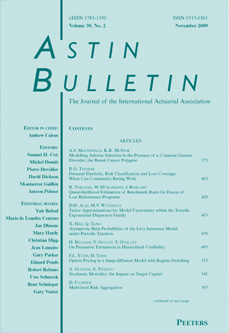 previous article in this issue previous article in this issue | next article in this issue  |

|
Document Details : Title: Global Warming, Extreme Weather Events, and Forecasting Tropical Cyclones Subtitle: A Market-Based Forward-Looking Approach Author(s): CHANG, Carolyn W. , CHANG, Jack S.K. , GUAN LIM, Kian Journal: ASTIN Bulletin Volume: 42 Issue: 1 Date: 2012 Pages: 77-101 DOI: 10.2143/AST.42.1.2160713 Abstract : Global warming has more than doubled the likelihood of extreme weather events, e.g. the 2003 European heat wave, the growing intensity of rain and snow in the Northern Hemisphere, and the increasing risk of flooding in the United Kingdom. It has also induced an increasing number of deadly tropical cyclones with a continuing trend. Many individual meteorological dynamic simulations and statistical models are available for forecasting hurricanes but they neither forecast well hurricane intensity nor produce clear-cut consensus. We develop a novel hurricane forecasting model by straddling two seemingly unrelated disciplines — physical science and finance — based on the well known price discovery function of trading in financial markets. Traders of hurricane derivative contracts employ all available forecasting models, public or proprietary, to forecast hurricanes in order to make their pricing and trading decisions. By using transactional price changes of these contracts that continuously clear the market supply and demand as the predictor, and with calibration to extract the embedded hurricane information by developing hurricane futures and futures option pricing models, one can gain a forward-looking market-consensus forecast out of all of the individual forecasting models employed. Our model can forecast when a hurricane will make landfall, how destructive it will be, and how this destructive power will evolve from inception to landing. While the NHC (National Hurricane Center) blends 50 plus individual forecasting results for its consensus model forecasts using a subjective approach, our aggregate is market-based. Believing their proprietary forecasts are sufficiently different from our market-based forecasts, traders could also examine the discrepancy for a potential trading opportunity using hurricane derivatives. We also provide a real case analysis of Hurricane Irene in 2011 using our methodology. |
